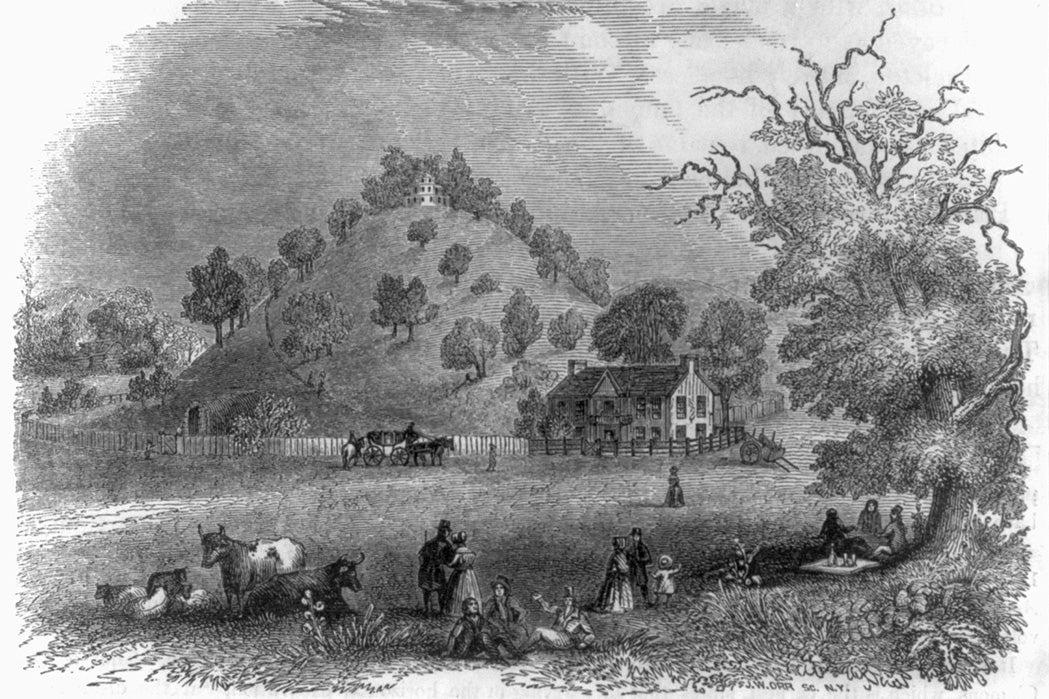Europeans and their descendants in North America sought to explain the origins of Indigenous peoples in ways that legitimized conquest. “The question of origins was central to the continued colonization in North America,” explains anthropologist Meghan C. L. Howey. “Having answers to the question of Native origins that challenged the magnitude, duration, and even the very legitimacy of Native Americans’ presence and tenure in America offered powerful colonial tools for furthering tribal land dispossession.”
In other words, “Native people had to be explained to be superseded.”
In 1784, enslaved workers unearthed a burial mound north of Charlottesville, Virginia, for Thomas Jefferson. It was one of the first archaeological excavations in North America. Jefferson surmised that the “Barrow” had been constructed by ancestors of living American Indians, and hypothesized that they were descendants of Asians—or, possibly, that Asians were the descendants of American Indians.
Jefferson’s ideas, however, were premature. Prevailing notions held that a “lost race” predated the Indians and built those mounds. These were a superior, more sophisticated people who had either been vanquished by the “red men” or degenerated into savagery in the American environment. A particularly enduring version was that the Indians were descendants of the Lost Tribes of Israel.
As the United States pushed into ever more “Indian territory,” a myth of a white “Mound Builder” race emerged from the Lost Tribes idea. The Mound Builders were supposed to have been overrun. This myth rationalized land-grabs, removals, and genocidal wars, because “if Indians killed a white race, the white race was justified in killing or removing them.”
In arguing for passage of the Indian Removal Act of 1830, for instance Andrew Jackson referred to “a once powerful race” exterminated or disappeared “to make room for the existing savage tribes,” just as the savage tribes would now have to make room for white Americans. Also in 1830, Joseph Smith’s Book of Mormon postulated that the children of Lehi, who had supposedly arrived in America from Jerusalem around 600 BC, divided into white-skinned Nephite farmers and red-skinned Lamanite raiders, the latter ultimately extinguishing the former. Another version of the myth is found in William Cullen Bryant’s 1832 poem “The Prairies,” in which “a disciplined and populous race” lived in Edenic happiness until “the red man came,” “warlike and fierce,” and “the mound-builders vanished from the earth.”
Actual indigenous Americans pushed back against ideas legitimizing extermination. Howey examines three American Indian authors who had “a keen understanding of the political and racial implications” of European Indian-origin stories. Kahkewaquonaby (Peter Jones), Kahgegagahbowh (George Copway), and William Whipple Warren were, from the mid-1830s through the 1850s, “embroiled in fights against colonial land grabs and removal policies” in both Canada and the US. They wrote for a white audience, arguing for rights, sovereignty, and above all historical legitimacy—particularly with an always/already here argument for native origins.
Weekly Newsletter
Their major works include Traditional History and Characteristic Sketches of the Ojibway Nation (Copway, 1850); History of the Ojibway People (Warren, 1851), and History of the Ojebway Indians; with Especial Reference to their Conversion to Christianity (Jones, published posthumously in 1861). All three men were culture-crossers. Jones and Copway were missionary Methodists; the colorful Copway was thrown out of the Canadian church for fraud and served a short prison sentence for it. Warren, who identified as “mixed blood,” was a government translator and Minnesota territorial legislator from 1851 until his death in 1853.
They quoted tribal elders on origins, becoming pioneers in oral history, and argued that origins were only a problem or puzzle for the whites. Copway and Jones dismissed the Lost Tribes of Israel idea while Warren held on to it. They all rejected the idea that white people had built the mounds. Jones wrote that “Indians are descendants of Asiatic Tartars.” Warren translated Anishinaabeg (an umbrella term for Ojibwe, Algonquin, Potawatomi, and other peoples) as “Spontaneous People”—indigenous, inherent, always present.
For all their all efforts, it wasn’t until 1894 that the Mound Builder myth was convincingly dismantled by a Smithsonian anthropologist named Cyrus Thomas. The myth lingered on and, as Howey notes, still circulates in some “cult archeology circles today.”







